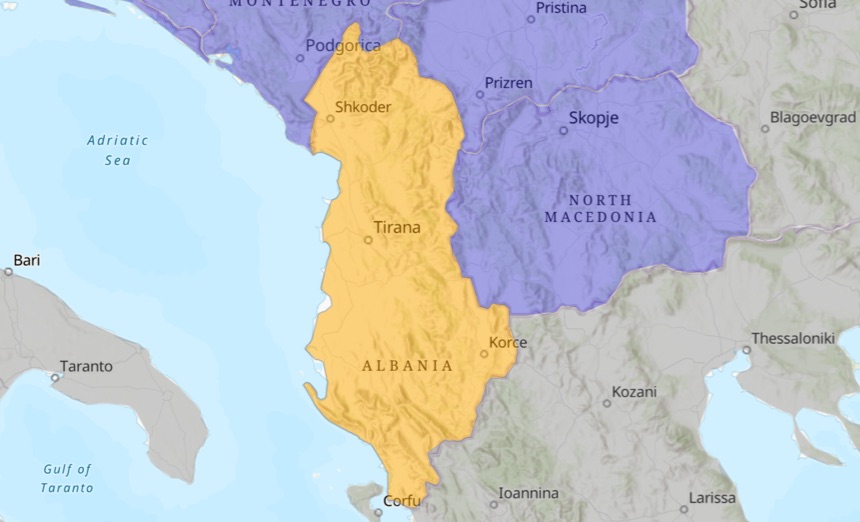The communist period (1946–91) in Albania was characterised by a massive accumulation of ammunition and weapons of Albanian, Chinese and Soviet origin. More than 100,000 tonnes of munitions and weapons were housed in various depots across the country. After 1991, these depots could not be maintained properly, further exacerbating a dangerous storage environment. A massive explosion at an ammunition dismantling facility occurred in 2008. In order to reduce the risk of further incidents, Albania began work to establish a legal framework for the demilitarisation of munitions and the upgrade of decrepit facilities. The international community provided the country with technical and financial assistance for this purpose.1
Albania has signed and ratified the Arms Trade Treaty. The South Eastern and Eastern Europe Regional Clearinghouse for the Control of Small Arms and Light Weapons (SEESAC) is currently implementing a project in the country to provide support for disarmament and arms control efforts, as well as to reduce the threats posed by illicit small arms and light weapons and their ammunition.2 The Organization for Security and Co-operation in Europe (OSCE) Presence in Albania and the Ministry of Interior also launched a three-year joint project in June 2022 to tackle the risk of weapons proliferation and the misuse of small arms and light weapons.3
1 Matt Goodyear, "Albania Makes Progress in Demilitarization," The Journal of ERW and Mine Action 14, no. 3 (2010): 16-19, https://commons.lib.jmu.edu/cgi/viewcontent.cgi?article=1376&context=cisr-journal.
2 “Ammunition Management Activity Platform (A-MAP),” GICHD, 2022, a-map.gichd.org.
3 OSCE, "OSCE Presence Launches Project for Reducing Risk of Weapon Proliferation and Misuse of Small Arms and Light Weapons in Albania," OSCE, June 9, 2022, https://www.osce.org/presence-in-albania/519963.
Launch the country dashboard
Further information
Accidental explosions
Since the Small Arms Survey began collecting data in 1979, 24 accidental explosions have been reported in Albania.
Table 1. Accidental explosions in Albania (1979–2021)
Year | Location | Owner/manager | Deaths | Injuries |
2011 | Skrapar | State (military) | 1 | 3 |
2009 | Polican | State (military) | 1 | 1 |
2008 | Gërdec | Non-state (company) | 26 | 300 |
2006 | Dhëmblan | State (military) | 2 | 3 |
1997 | Burrel | State (military) | 27 | N/A |
1997 | Fushe-Kruje | State (military) | N/A | N/A |
1997 | Gjegjan | State (military) | 30 | 3 |
1997 | Gjeroven | State (military) | 3 | 0 |
1997 | Gjirokastër | State (military) | 3 | 14 |
1997 | Klos | State (military) | 3 | 1 |
1997 | Kordhoc | State (military) | 1 | 2 |
1997 | Laci | State (military) | 3 | 9 |
1997 | Malesia Lezhe | State (military) | 7 | 0 |
1997 | Mbreshtan | State (military) | 2 | 1 |
1997 | Palikesht | State (military) | 0 | 14 |
1997 | Peshkopi | State (military) | 0 | 3 |
1997 | Picar | State (military) | 4 | 10 |
1997 | Picar | State (military) | 5 | 19 |
1997 | Pilur-Vlore | State (military) | 2 | 0 |
1997 | Qafe Shtame | State (military) | 23 | 3 |
1997 | Shen Vasil/Sasaj | State (military) | 3 | 0 |
1997 | Suc | State (military) | 1 | 2 |
1997 | Ura e Gjadrit | State (military) | 6 | 2 |
1997 | N/A | State (N/A) | 16 | N/A |
Source: “Unplanned Explosions at Munitions Sites (UEMS) Database,” Small Arms Survey, updated December 15, 2021, https://smallarmssurvey.org/database/unplanned-explosions-munitions-sites-uems.
Cases of diversion
Numerous cases of diversion have been reported in Albania.
Table 2. Cases of diversion of arms, ammunition and explosives in Albania
Year | Location | Description |
1997 | Throughout the country | Groups of people and criminal gangs looted weapons, ammunition and grenades from the state warehouses – including 839,310,038 items of ammunition, 16,000,000 items of explosives and 549,775 weapons. |
Sources: "Albania and the Disposal of Surplus Ammunition," Comitato Atlantico Italiano, 2019, http://www.comitatoatlantico.it/COMIT/documenti/albania-and-the-disposal-of-surplus-ammunition; SEESAC, Small Arms and Light Weapons, their Ammunition and Explosives Control Strategy 2019-2024 (Belgrade: SEESAC, 2018), https://www.seesac.org/f/docs/Albania-1/ENG_Albanian_Strategy_on_Firearms_Control-24-06-2019.pdf.
Disposal
To decrease the above-mentioned risks of accidental explosions and diversion, Albania regularly disposes of its ammunition.
Table 3. Disposal of tonnes of ammunition in Albania
Year | Tonnes of ammunition |
2014 | 3,527 |
2013 | 12,169 |
2012 | 25,498 |
2011 | 26,613 |
2010 | 20,653 |
2009 | 6,540 |
2002–08 | 75,000 |
Sources: "Disposal of Surplus Ammunition," Comitato Atlantico Italiano; "Action Plan for the Disposal of Ammunition in 2014," Ministry of Defence of the Republic of Albania, 2022, https://www.mod.gov.al/eng/security-policies/others-from-mod/demilitarization.
Needs
To further enhance safe and secure ammunition management, the following need has been identified for Albania:
- Development or refinement of standards and procedures on stockpile management, in particular – technical and financial assistance required for upgrade of security infrastructure of SALW and ammunition storage.
Source: Albania, National PoA Report on the Implementation of the Programme of Action on Small Arms and Light Weapons (PoA) and the International Tracing Instrument (ITI) (New York: Permanent Mission of Albania to the UN, 2022), https://unoda-poa.s3.amazonaws.com/reports/ALB-English-1234-SUBMITTED.pdf.



